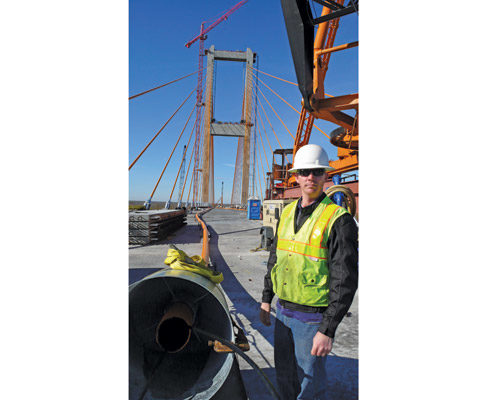It will be late summer before drivers cross the longest cable-stayed bridge in the Western Hemisphere, yet for Frank Daams, the new bridge essentially was complete in early January when crews installed the last two 830-ft-long cables and stressed each of their 44 steel strands.
“As far as I’m concerned, it is finished,” says Daams, project manager for Audubon Bridge Constructors, a joint venture of Flatiron Constructors Inc., Longmont, Colo.; Granite Construction, Watsonville, Calif., and Parsons Transportation Group Inc., Washington, D.C. “Now all we have are little details to get it open to traffic.”
The John James Audubon Bridge crossing the Mississippi River between New Roads and St. Francisville, La., is the centerpiece of a $408.5-million project that began in May 2006. It includes 12 miles of approach roadway and seven conventional bridges. The 2.44-mile-long crossing has a 1,583-ft main span and two H-frame pylons higher than 520 ft.
The last, 45-ft-long steel connecting span was placed on Dec. 29. “We hung the last beam with a gap of four inches,” Daams says. The next day, ABC used 50-ton hydraulic jacks to scoot the central spans into perfect alignment. “Can you imagine starting 1,500 ft apart and it comes together within inches? That feels pretty good,” Daams says. But it didn’t feel finished for the project manager until the final cables were hung.
Having already attached to the bridge decks and pylons 134 cables varying from 225 ft to 830 ft long, on the day the last cables were strung, the crew was obviously adept at the process. Still, handling the 200-mm-dia, 829.64-ft-long cables is “like wrestling an anaconda,” says Wayne Marchand, deputy program manager with Louisiana’s Transportation Infrastructure Model of Economic Development.

DAAMS
To assist with its $5-billion, TIMED program, the Louisiana Dept. of Transportation and Development hired LTM, a joint venture of GEC Inc., Metairie, La.; PB Americas Inc., New York City, and The LPA Group Inc., Columbia, S.C.
Jacob Kern, ABC field engineer, says, “The deck is only so long, and there is a maximum radius we can bend it and not kink it.”
What motorists will see as 17 stay cables on each face of the pylons are actually the orange, carbon-lined, high-density polyethylene pipes (HDPE) housing the 0.68-in.-dia steel strands. The smallest cable on the bridge comprises 21 strands and the largest comprises 69.
To install the cables, crews thread one strand of the requisite length of high-density polyethelene pipe, with the tip sawed down to expose the central wire of seven galvanized wires that make a strand. A removable sleeve protects the HDPE pipe during the lift. Workers attach crane lead lines to both the strand and the sleeve for dual lifting points from the deck.
Crews feed cables through pre-cast holes in the H pylons. They winch each strand into a predetermined configuration inside the round anchor heads in cable boxes cast into the concrete. Once the top end is attached, the deck end is secured.
“The biggest challenge on stays is that every one is different, with a different number of strands and different length,” Kern says. The first strand that guides the HDPE cable sleeve has a lot of slack. “When we first get it up there to get the stay pipes to go in place, depending upon the length of the stay, there is approximately 25 to 65 ft of excess length in the strand before stressing,” says Sarah Tacker, ABC deputy project manager.
Kern says they had to pull about 70 ft of excess on the first strand of the 830-ft-long cable to get the slack out. Strands feed into the anchor head and are held by small wedges machined with fine teeth that “bite” onto the strand. A computer-monitored, hydraulic jack pulls on the strand in strokes until it is properly stressed. Typically, ensuing strands only require about 24 in. to be pulled through to achieve proper tensioning, Kern says.
Each strand undergoes three phases of stressing. During installation, when forces are relatively low, crews apply 75 to 1044 kips, Tacker says. After setting deck panels, they stress strands higher and apply the final round after placing the concrete infill. Once each strand is sufficiently stressed, workers cut off the tails, encase the ends in epoxy and cover them with removable steel caps.
With the last cable installed, several months of work remain for others to complete, but Daams will move on to another suspension bridge, in San Francisco. Flatiron and Kiewit recently won a public-private partnership contract to rebuild the approaches to the Golden Gate. “It’s cleanup time here,” he says.







Post a comment to this article
Report Abusive Comment